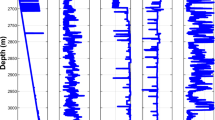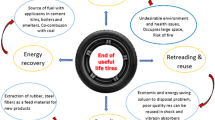Abstract
Above-ground Norway spruce telecommunication poles impregnated with creosote in 1965 were subjected to regular in situ inspection near the end of their service-life in 2013 using also ultrasonic (Fakopp Ultrasonic Timer) and drill-resistance (Resistograph IML-Resi-F-400) techniques. The 1.2 m-long bottom parts of five poles proposed for exchange underwent more detailed in vitro analyses using ultrasonic, drill-resistive and computed tomography (Philips Brilliance CT) techniques followed by visualization of their 11 cut sections. All analyses showed that the most significant decays in poles occurred between the two mounting holes provided to secure the pole to the steel–concrete footings using steel bolts. Observations made by the ultrasonic, drill-resistive and CT techniques and final visualization of the cut sections yielded significant correspondence. In conditioned poles, the CT well identified moderate, severe and very severe degrees of bio-attacks, however it was not the best in detecting slight bio-damages.









Similar content being viewed by others
References
Arita K, Mitsutani S, Sakai H, Tomikawa Y (1986) Detection of decay in the interior of a wood post by ultrasonic method. Mokuzai Kogyo 41(8):370–375
Bergman Ő, Jermer J (2010) Glued laminated poles—Progress report after 30 years’ testing. IRG/WP 10-20427, p 11
Brischke C, Rapp AO (2010) Service life prediction of wooden components—part 1: determination of dose-response functions for above ground decay. IRG/WP 10-20439, p 14
Costa AF, Teles RF, Goncalves JC (2010) Stress wave and visual analysis of treated and non-treated fence posts after 15 years in field test. IRG/WP 10-20449, p 11
Crews KI, Horrigan A, Boughton GN (1998) Assessment of characteristic properties for utility poles in Australia. In: Proceedings from the 5th World Conference on timber engineering, Montreux, Switzerland, pp 626–633
Daugherty GL (1998) The realistic expectation of an in-place wood pole inspection program. In: Utility poles and structures (Revised version of a paper presented at the International Conference on Utility Line Structures, Mar 23–25, 1998, Fort Collins, Florida, USA), p 8
Edlund M-L, Evans F, Henriksen K (2006) Testing durability of treated wood according to EN 252—interpretation of data from Nordic test fields. NT Technical report 591, Nordic Innovation Centre, Oslo, Norway, p 16
EN 335 (2013) Durability of wood and wood-based products. Use classes: definition, application to solid wood and wood-based products. CEN, Brussels, Belgium
EN 252 (1997) Field test method for determining the relative protective effectiveness of a wood preservative in ground contact. /EN 252: 1989 including its corrigendum AC 1/. CEN, Brussels, Belgium
Francis LP, Swain AJ, Morrell JJ (2007) Predicting the decay resistance of timber above-ground: 2. When can reliable field data be obtained? IRG/WP 07-20368, p 12
Graham RD, Helsing GG (1979) Wood pole maintenance manual: inspection and supplemental treatment of Douglas-fir and western red cedar poles. Forest Research Laboratory, Oregon state university—Corvallis Research. Bulletin 24(2):64
Hansson L, Cherepanova E (2012) Determination of wood moisture properties using a CT-scanner in a controlled low-temperature environment. Wood Mat Sci Eng 7(2):87–92
Jackson A (2011) Preservative choices for wood utility poles. Electric light & Power, 16(10): 4. http://www.elp.com/articles/powergrid_international
Jenkins E (2011) Inspecting poles in the 21st century. Utility Products 1: 24–25. http://www.utilityproducts.com
Kloiber M, Bláha J (2005) Nedestruktivní identifikace poškození dřevěných nosných konstrukcí u památkově chráněných objektu (Non-destructive testing of damages in timber structures of heritage protected objects). In: L Reinprecht, P Hlaváč, J Gáper (eds). Drevoznehodnocujúce huby 2005, 4th conference on wood-destroying fungi 2005, TU Zvolen, Slovakia, pp 69–75
Liang S, Hu N, Lin L, Fu F (2009) Detection and assessment healthy situation of Poulus eupharatica Oliv. with stress wave. IRG/WP 09-20415, p 7
Macchioni N, Palanti S, Rosenberg P (2007) Measurements of fungal wood decay on Scots pine and beech by means of X-ray microdensitometry. Wood Sci Technol 41(5):417–426
Makovíny I, Reinprecht L (1990) Možnosti stanovenia hniloby dreva formou jeho elektrofyzikálnych vlastností (Rot in wood determined by its electro-physical properties). In: Ochrana dreva, 8th conference on wood protection, DT Bratislava, Slovakia, pp 70–74
Marčok M, Reinprecht L, Beničák J, Polášek J, Danko P (1996) Detection of biodegradation processes in specimens from damaged spruce beam by means of ultrasonic and microwave methods. In: Acoustics’ 96, 3rd International Colloqium, TU Zvolen, Slovakia, pp 5–13
McGee PB (2014) Wood pole inspection and testing. Incident Prevention Magazine, p 4. http://www.incident-prevention.com/ip-articles/wood-pole-inspection-and-testing
Pellerin RF, Ross RJ (2002) Inspection of timber structures using stress wave timing nondestructive evaluation tools. In: Pellerin RF, Ross RJ (eds) Nondestructive evaluation of wood. Forest Product Society, Madison, pp 135–148
Peylo A, Bechgaard CG (2006) Field tests on poles—a report from practice. IRG/WP 06-20343, p 9
QWEST (2010) Pole inspection process. In: International telecommunications safety conference, Denver. http://www.telsafe.org
Reinprecht L, Hrivnák J (2010) Stanovenie hniloby i iných defektov v drevených prvkoch ultrazvukom a odporovým vrtákom—v kostole v Trnovom a nedokončenom zrube (Determination of rot and other defects in wooden elements by ultrasonic method and by Resistograph—in ancient wooden church in Trnovo and in one new un-completed log house). In: Sanace a rekonstrukce staveb, 32nd Conference, WTA Brno, Czech Republic, pp 33–40
Reinprecht L, Pánek M (2013) Ultrasonic technique for evaluation of biodefects in wood: part 2—in situ and in vitro analyses of old beams using ultrasonic and bending tests. Int Wood Prod J 4(1):22–29
Reinprecht L, Novotná H, Štefka V (2007) Density profiles of spruce wood changed by brown-rot and white-rot fungi. Wood Res 52(4):17–28
Rinn F (2013) Technical inspection of a Northern red oak. Expert report, Engineering and Expert-office, Olmsted-Falls, Ohio, USA
Rinn F, Schweingruber FH, Schär E (1996) Resistograph and X-ray density charts of wood. Comparative evaluation of drill resistance profiles and X-ray density charts of different wood species. Holzforschung 50:303–311
RUS—rural utilities service (1996) Pole inspection and maintenance. RUS Bulletin 1730B-121, USDA, Washington, DC
Schmidt O (2006) Wood and tree fungi—biology, damage, protection, and use. Springer, Berlin, Heidelberg, Germany
Senalik CA (2013) Detection and assessment of wood decay—glulam beams and wooden utility poles. Dissertation, University of Illinois at Urbana-Champaign, Illinois, USA, p 232
Tallavo F, Cascante G, Pandey MD (2012) A novel methodology for condition assessment of wood poles using ultrasonic testing. NDT & E Int 53:149–156
Tomazello M, Brazolin S, Chagas MP, Oliveira JTS, Ballarin AW (2008) Application of X-ray technique in nondestructive evaluation of Eucalypt wood. Maderas. Clencia y tecnologia 10(2):139–149
Van den Bulcke J, De Windt I, Van Acker J (2011) Non-destructive evaluation of wood decay. IRG/WP 11-20479, p 11
Wilcox WW (1988) Detection of early stages of wood decay with ultrasonic pulse velocity. For Prod J 38(5):68–73
Acknowledgements
The authors express their gratitude to the Grant Agency of the Slovak Republic, Projects VEGA 1/0574/12 and APVV-0200-12, for the financial support of this work.
Author information
Authors and Affiliations
Corresponding author
Rights and permissions
About this article
Cite this article
Reinprecht, L., Šupina, P. Comparative evaluation of inspection techniques for impregnated wood utility poles: ultrasonic, drill-resistive, and CT-scanning assessments. Eur. J. Wood Prod. 73, 741–751 (2015). https://doi.org/10.1007/s00107-015-0943-8
Received:
Published:
Issue Date:
DOI: https://doi.org/10.1007/s00107-015-0943-8




